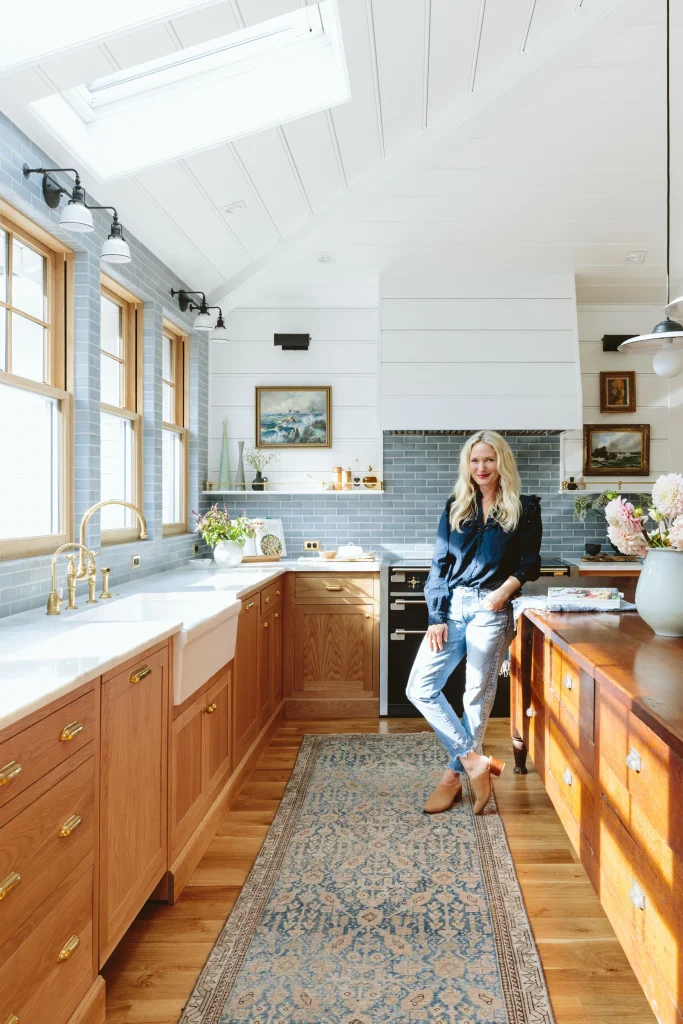Yes, placing a rug in the kitchen is a good idea as it adds warmth, comfort, and can protect your floors from spills and stains. A well-chosen rug can enhance the overall aesthetic of your kitchen while providing a cushioning effect for your feet as you prepare meals and do cleaning tasks. Should You Put a Rug In a Kitchen? let’s explore.
Additionally, a rug can help reduce noise and create a defined space in an open-plan kitchen. With a variety of options available, such as washable rugs or stain-resistant materials, it is essential to choose a rug that is easy to clean and maintain in a high-traffic area like the kitchen.
So, consider adding a rug in your kitchen to elevate its style and functionality.
Benefits Of Having A Rug In The Kitchen
Benefits of Having a Rug in the Kitchen
A rug in the kitchen can bring numerous benefits, besides just adding a decorative touch. Let’s break down the advantages of having a rug in the kitchen.
Protection For The Floor
Rugs act as a protective layer for your kitchen floor, preventing scratches and stains from daily wear and tear. They reduce the risk of damage, ensuring your flooring stays in good condition for longer.
Comfort And Insulation
Placing a rug in the kitchen can provide a comfortable cushion underfoot, reducing fatigue from standing for long periods while cooking or doing dishes. Additionally, rugs offer insulation, helping to keep the kitchen space warm and cozy, especially in colder climates.
Style And Design
A well-chosen rug can elevate the visual appeal of your kitchen, adding texture, color, and pattern to the space. It serves as a design element that ties the room together, creating a cohesive and inviting atmosphere. Whether you opt for a modern or traditional style, a rug can enhance the overall aesthetic of your kitchen.

Credit: www.walmart.com
Considerations When Choosing A Rug For The Kitchen
When it comes to adding warmth and style to your kitchen, a rug can be a great option. However, choosing the right rug for this high-traffic area requires careful consideration. By taking into account factors such as material and durability, size and shape, and maintenance and cleaning, you can make an informed decision that not only enhances the aesthetics of your kitchen but also withstands the demands of this busy space.
1. Material And Durability
Choosing a rug made from durable and easy-to-clean materials is crucial when it comes to kitchen rugs. Since kitchens are prone to spills and stains, it’s important to opt for materials that can withstand frequent cleaning and maintain their appearance over time. Consider investing in rugs made from synthetic fibers like nylon or polyester, which are not only stain-resistant but also highly durable. Natural materials like cotton and wool can also be suitable options, as they offer a cozy and soft feel underfoot.
2. Size And Shape
When selecting a rug for your kitchen, it’s essential to pick a size and shape that complements the layout of the space. A well-fitting rug can define different areas within your kitchen, making it visually appealing. Measure the available floor space and consider the location of kitchen cabinets and appliances to determine the ideal dimensions. In terms of shape, rectangular and round rugs are popular choices for kitchens, but you can also experiment with unique shapes like oval or square to add an interesting element to your kitchen decor.
3. Maintenance And Cleaning
Keeping your kitchen clean and hygienic is vital for a healthy cooking environment. Therefore, it is essential to select a rug that is easy to maintain and clean. Look for rugs that are labeled as machine-washable or stain-resistant, as these can be easily cleaned and maintained. Additionally, consider the thickness and pile height of the rug. Low-pile rugs are generally easier to clean, as they are less likely to trap dirt and debris, while high-pile rugs may require more effort to keep clean.
Regularly vacuuming your kitchen rug will help remove any loose dirt and debris, while spot cleaning with a mild detergent can tackle any spills or stains. It is also advisable to check the manufacturer’s cleaning instructions and recommendations for your specific rug to ensure proper care and maintenance.
By considering the material and durability, size and shape, and maintenance and cleaning requirements, you can confidently choose a rug that not only enhances your kitchen’s appearance but also withstands the demands of this culinary hub.
Risks And Drawbacks Of Using A Rug In The Kitchen
When it comes to decorating your kitchen, adding a rug can be a tempting idea. Not only can it add a pop of color and texture to the space, but it can also provide a cozy feeling underfoot. However, before you start rolling out the rug, it is important to consider the risks and drawbacks associated with placing a rug in the kitchen. Safety hazards, hygiene concerns, and maintenance challenges are all factors that need to be taken into account.
Safety Hazards
Placing a rug in the kitchen can potentially pose safety hazards, especially if it is not secured properly. Rugs with slippery surfaces or loose edges can easily cause someone to slip and fall, leading to injuries. Additionally, rugs that are not flame-resistant can become a fire hazard if accidentally exposed to heat sources such as stovetops or ovens. It’s crucial to ensure that your kitchen rug is securely anchored to the floor and is made of non-slip materials to minimize the risk of accidents.
Hygiene Concerns
Keeping the kitchen clean and hygienic is essential for maintaining a healthy environment. Unfortunately, rugs tend to accumulate dirt, food particles, and spills, making them a breeding ground for bacteria and germs. This is particularly concerning in a kitchen where food is prepared. Rugs can also trap moisture, leading to mold and mildew growth, which can further compromise hygiene. Regular vacuuming and spot cleaning can help mitigate these issues, but it may not be enough to keep the rug completely free of bacteria and allergens.
Maintenance Challenges
Maintaining a rug in the kitchen can be challenging due to the high-traffic nature of the space. Constant foot traffic, spills, and kitchen mishaps can quickly take a toll on the rug’s appearance. Cleaning a rug that is placed in the kitchen requires more effort and vigilance compared to rugs in other areas of the home. Additionally, certain types of rugs may not withstand frequent cleaning or exposure to water. Therefore, if you choose to put a rug in your kitchen, you must be prepared to invest time and effort into its regular maintenance.
Tips For Using A Rug In The Kitchen
When it comes to adding warmth and style to your kitchen, placing a rug can be a game-changer. However, if you’re wondering, “Where should I put rugs in my kitchen?” and “Should I put a rug by my kitchen sink?”, here are some essential tips to consider before tossing that rug onto the kitchen floor.
1. Use Non-slip Rug Pads
To prevent slips and falls, it’s crucial to use non-slip rug pads underneath the kitchen rug. These pads provide traction and stability, especially in high-traffic areas. They also protect the floor from scratches and help the rug lay flat, creating a safer and more comfortable environment.
2. Choose Easy-to-clean Rugs
Select easy-to-clean rugs, like machine-washable or low-pile options, to ensure simple maintenance. Kitchens are prone to spills and splatters, so having a rug that can be readily cleaned will save you time and effort. Additionally, opt for materials that can withstand regular cleaning, such as polypropylene or cotton.
3. Consider Rug Placement
Regarding rug placement, it’s essential to decide where the rug will best serve your needs. If you’re wondering, “Is it OK to put carpet in the kitchen?” and “Should you put a rug under your kitchen table?”, consider placing a rug by the sink or stove to provide cushioning and protect the floor. For dining areas, make sure the rug is large enough to accommodate the chairs even when pulled out. Moreover, a runner rug can be ideal for the high-traffic areas.
Alternatives To Rugs In The Kitchen
When it comes to decorating your kitchen, rugs are a common choice for bringing warmth and style to the space. However, there are alternatives to rugs that can also serve as practical and attractive additions to your kitchen. Whether you’re concerned about cleanliness, durability, or simply want to try something different, here are a few alternatives to consider.
Vinyl Or Laminate Flooring
If you want a low-maintenance option that still provides a soft underfoot feel, vinyl or laminate flooring can be a great alternative to rugs in the kitchen. These materials offer the benefits of being highly durable, waterproof, and easy to clean, making them perfect for high-traffic areas like the kitchen. Additionally, vinyl and laminate flooring come in a range of designs and patterns, allowing you to achieve the look of a rug without the hassle of upkeep.
Washable Kitchen Mats
A washable kitchen mat is another practical alternative to rugs. These mats are specifically designed for the kitchen, with features such as slip-resistant backing and stain-resistant surfaces. They can be easily placed in front of the sink or stove, providing comfort and protecting your floors from spills and splashes. Best of all, washable kitchen mats can be thrown in the washing machine for easy cleaning, ensuring that your kitchen stays clean and fresh.
Cork Or Bamboo Flooring
If you’re looking for a more eco-friendly alternative to rugs, cork or bamboo flooring can be a great choice. Cork flooring is made from the bark of the cork oak tree, making it a renewable and sustainable material. It’s also naturally resistant to moisture and stains, making it ideal for kitchen use. Similarly, bamboo flooring is another eco-friendly option that offers durability and a unique aesthetic. Both cork and bamboo flooring can be easily cleaned and maintained, making them a practical alternative to rugs in the kitchen.

Credit: stylebyemilyhenderson.com
Frequently Asked Questions For Should You Put A Rug In A Kitchen?
Can You Put A Rug In The Kitchen?
Yes, you can put a rug in the kitchen to add warmth and style to the space.
What Are The Benefits Of Having A Rug In The Kitchen?
Having a rug in the kitchen can provide cushioning, reduce noise, protect your floors, and add visual interest.
What Type Of Rug Is Best For The Kitchen?
Opt for a durable and stain-resistant rug made of materials like cotton, jute, or polypropylene that can handle spills and foot traffic.
How Do I Clean A Kitchen Rug?
Regularly vacuum your kitchen rug and spot clean any spills immediately using a gentle detergent or carpet cleaner for stubborn stains.
Conclusion
Ultimately, the decision to put a rug in your kitchen depends on your personal preferences, lifestyle, and needs. While rugs can add warmth and style to the space, they also require regular maintenance. Before making a decision, consider the practicality and functionality of having a rug in your kitchen.
Experiment with different options to find the best fit for your kitchen space.










